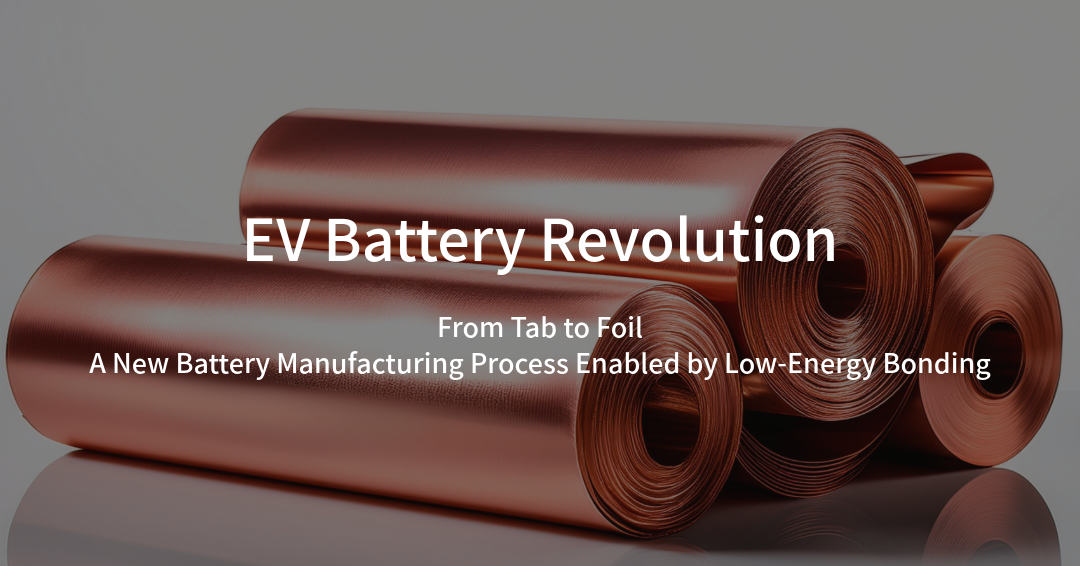The performance of an EV battery isn't solely defined by cell materials. The bonding of internal current collection tabs and external terminals profoundly impacts reliability and manufacturing efficiency. In today's high-energy-density cells, the bonding between battery foil and tabs has become a critical mass-production challenge, with conventional methods showing limitations in yield, safety, and cost.
The Ultrasonic Complex Vibration Bonding (UCVB) technology developed by LINK-US can overcome these limitations in tab-to-foil bonding.
table of contents
The Challenge of Battery Foil Bonding
Lithium-ion batteries are constructed from electrode plates—thin metal foils of copper or aluminum, typically to a few thick, coated with active material. These electrode foils are bonded to external terminals to extract electrical energy, but traditional bonding methods face numerous issues:
- Post-Weld Re-solidification: Causes welding defects like "foil tearing" and limits the number of layers that can be joined.
- Thermal Damage from Heat Input: Reduces the expected lifespan of resin components like gaskets, leading to electrolyte leakage and insulation breakdown.
- Conventional Ultrasonic Bonding Flaws: Burr and contamination act as physical short-circuit factors, leading to heating and potential fire.
- Maintenance Downtime: Halting the line for maintenance reduces production efficiency and increases costs.
Electrode foil is a "difficult-to-handle component," and improving bonding quality has been a major industry hurdle.
The Breakthrough of LINK-US's Low-Energy Bonding
Unlike conventional methods that rely on melting, LINK-US's UCVB achieves atomic-level bonding using complex vibration without melting the materials. Its characteristics are perfectly suited for battery foil bonding:
- High-Quality Solid-State Bonding: Eliminates foil tearing and vastly increases the maximum number of layers that can be joined.
- Reduced Thermal Impact: Extends cell lifespan.
- Contamination Mitigation: Improves market reliability and enables safer, higher-capacity designs.
- Extended Line Operation: Achieves higher productivity and lower costs.
Furthermore, its capability to handle dissimilar material combinations like Cu–Al and Cu–Ni flexibly adapts to future high-power and high-capacity cell designs.
Impact on Manufacturing Process Improvement
Implementing UCVB for electrode foil and tab bonding provides the manufacturing floor with significant benefits:
- Improved Yield: UCVB dramatically reduces burr and contamination generation compared to conventional ultrasonic bonding, minimizing foreign material intrusion and improving first-pass yield and productivity.
- Process Reduction: UCVB allows for bonding of a greater number of stacked electrode plates than conventional ultrasonic bonding, contributing to process elimination.
- Enhanced Cell Quality: UCVB enables lower-damage bonding than conventional ultrasonic methods, improving cell quality and resistance to aging.
- Expanded Design Freedom: UCVB allows for more diverse dissimilar material bonding than conventional ultrasonic methods, supporting the realization of new materials and structures required for next-generation cells.
Broadening Impact on the EV Industry
Innovation in bonding electrode foil, tabs, and terminals will not be limited to the cell itself; it will propagate to module and pack assembly. For example:
- Improved Mass-Production Efficiency for High-Capacity Cells: Boosts production capacity on a GWh scale.
- Enhanced Safety: Improves bonding quality in cell interconnects.
- Applicability of Lightweight Materials: Opens the door for exploring organic materials previously challenging to join with dissimilar metals.
This enables EV manufacturers to establish a competitive edge in driving range and cost, and provides end-users with safer, more reliable batteries.
Summary
Bonding in battery assembly has been called the "final frontier" of EV battery manufacturing. LINK-US's Ultrasonic Complex Vibration Bonding solves this complex problem through low-energy, low-heat solid-state bonding.
By simultaneously improving yield, reducing processes, and enhancing cell performance, this technology is truly opening the door to a new battery manufacturing process standard.
→ For detailed technical review or to discuss a Proof of Concept (PoC), please contact LINK-US.

